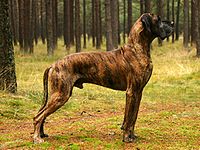
Photo from wikipedia
Simple Summary Leptospires are bacteria of major health concern as they can cause severe systemic diseases in humans and animals alike. In routine diagnostics, the detection of a leptospirosis heavily… Click to show full abstract
Simple Summary Leptospires are bacteria of major health concern as they can cause severe systemic diseases in humans and animals alike. In routine diagnostics, the detection of a leptospirosis heavily relies on the analysis of specific antibodies that were generated by the immune system of an infected species. The most widely used test for the detection of such antibodies is the microscopic agglutination test which itself depends on defined types of laboratory grown Leptospires, so-called serovars. A good judgment of the behaviour of these serovars is vital for interpreting test results and clearly defining what type of Leptospires the patient is infected with as this may have implications for therapy and prognosis. In the following, a study on the reaction pattern of a certain type of serovars named ‘Grippotyphosa’ that itself can be divided into two differently reacting subtypes was conducted. It turned out that, depending on the animal species sampled, a differing reaction patterns to the two Grippotyphosa subtypes in the diagnostic test reflected different distribution of these subtypes in the respective populations. In the future, these insights will further improve test performance and assessment or results. Abstract The MAT test is of great importance in the diagnosis of leptospiral infections. Based on various differences, the serovar Grippotyphosa has been divided into two types, Moskva V and Duyster. Differences or similarities of the two type strains in the context of leptospiral diagnostics have not yet been elucidated in more detail; therefore both strains were analysed in MAT diagnostics for the detection of leptospiral infections in pigs, dogs and horses. Serum samples from 2996 pigs, 55 dogs and 35 horses, as well as vitreous and/or aqueous fluid samples from these and 13 additional horses were analysed by MAT; available supplementary samples were tested for leptospires by PCR. In pigs, 92.6% of the samples with both strains received an identical titre result in the MAT test, whereas in dogs and horses only 53.0% and 43.6% had concordant results. Since infections with the serovar Grippotyphosa occur more frequently in dogs and horses overall, more differences were observed here. In the case of discrepant serological results, supplementary samples and PCR examinations were not able to add information on the true status. Further analyses of follow-up studies or at least serum pairs from dogs and horses infected with the serovar Grippotyphosa are necessary.
Journal Title: Veterinary Sciences
Year Published: 2022
Link to full text (if available)
Share on Social Media: Sign Up to like & get
recommendations!